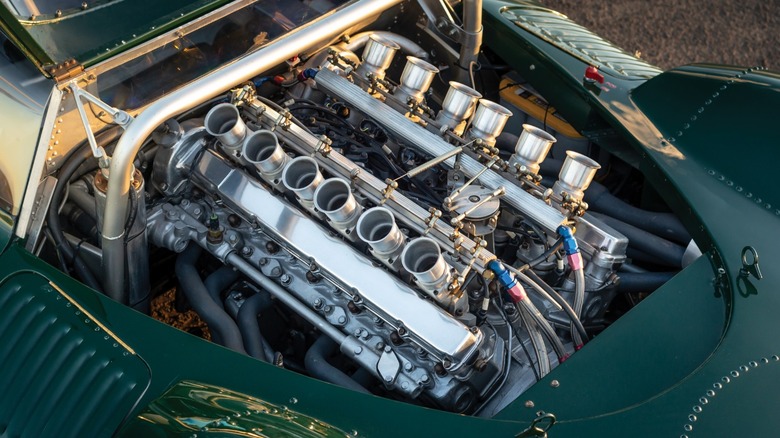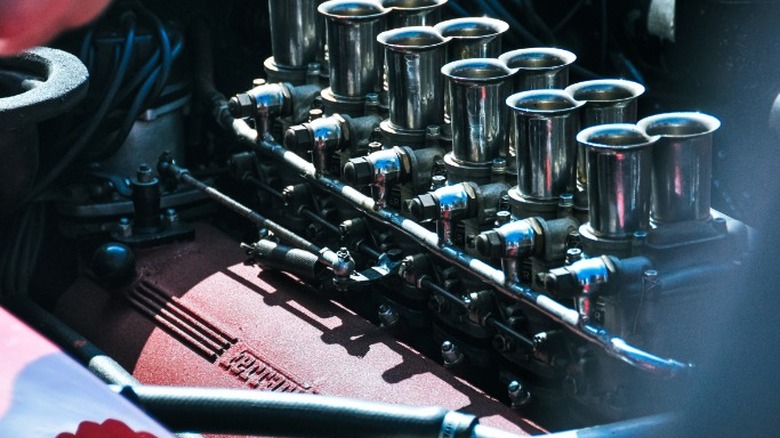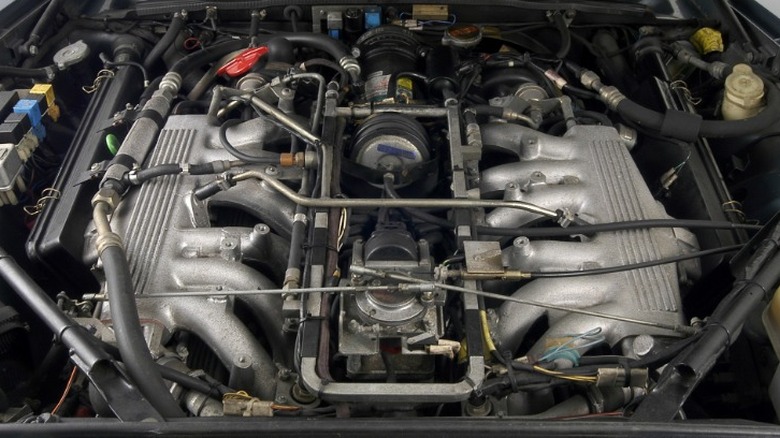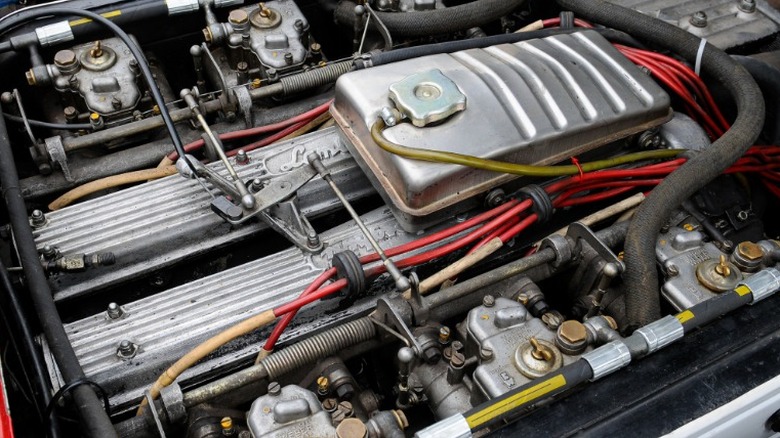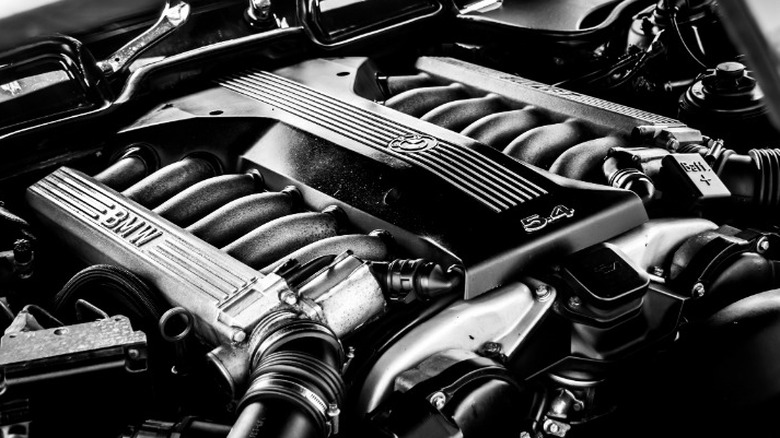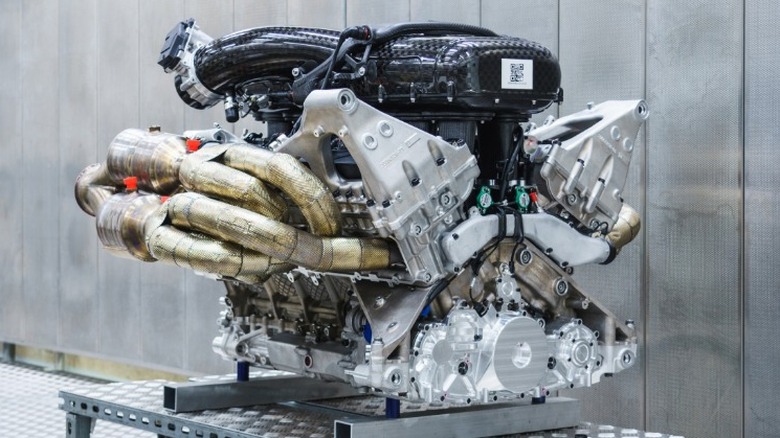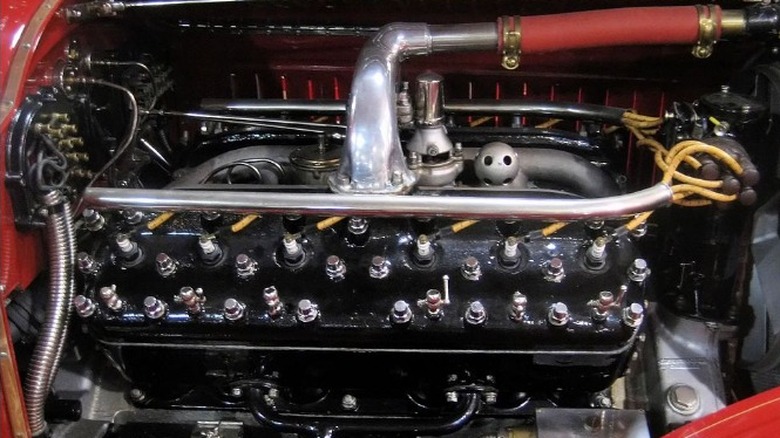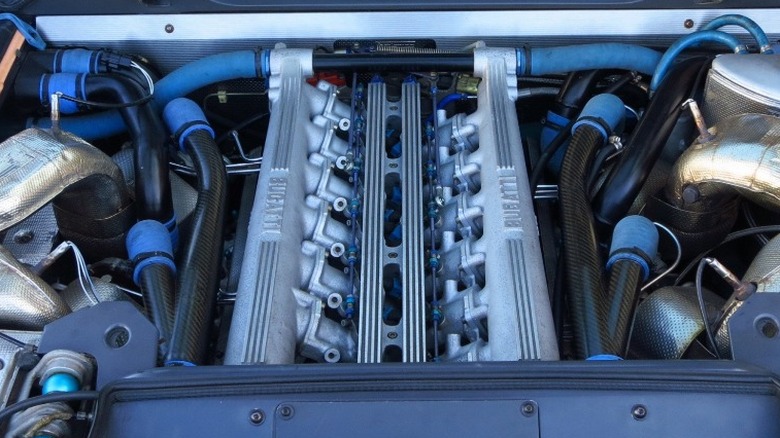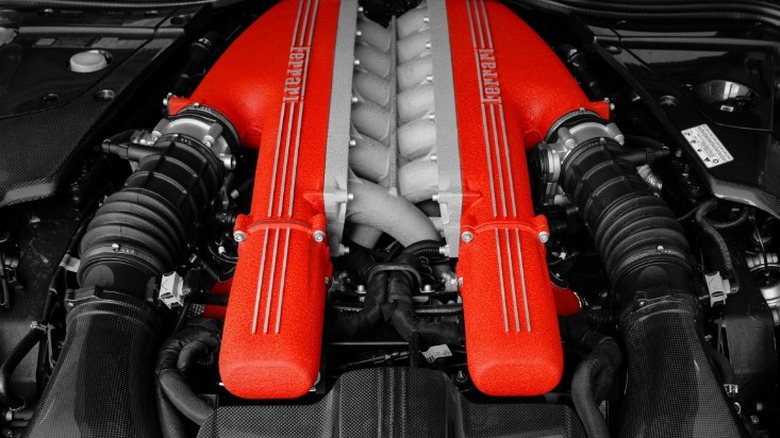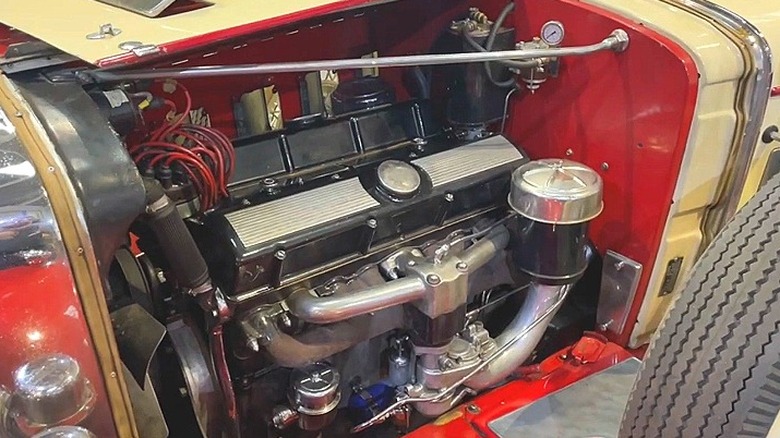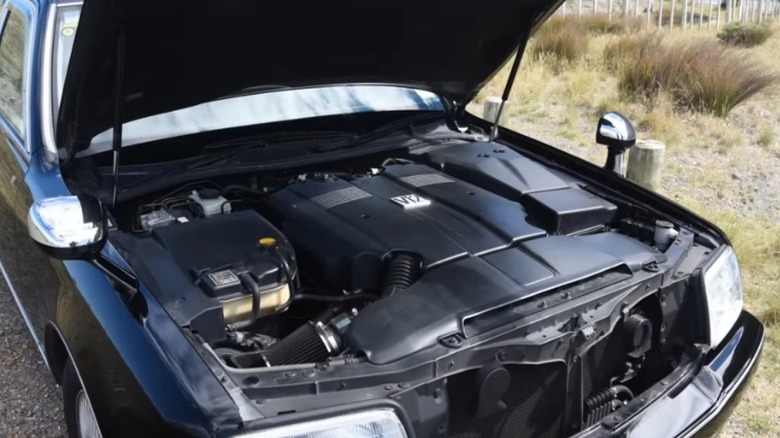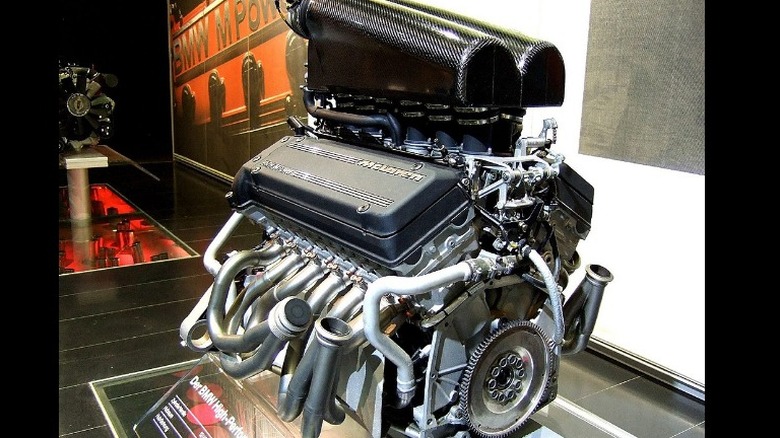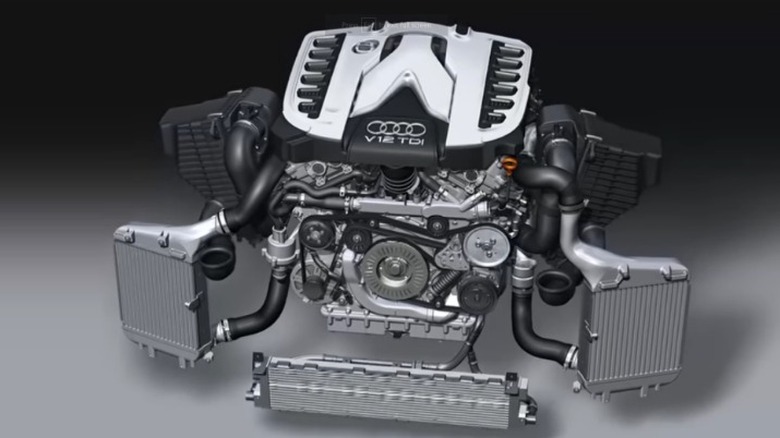The 12 Best V12 Engines Ever Made
There are many ways to boost an engine's power, but one of the oldest tricks is to add cylinders. The V12 has powered some of the most fascinating and sought-after vehicles of all time. Creating an engine with 12 cylinders was once the best way to achieve the highest power output, and inherent to the V12 architecture are low vibration and smooth power delivery. Furthermore, according to Engineering Explained on YouTube, the mechanics of a V12 engine allow it to be built with much smaller cylinders and reach a much higher RPM, thus delivering more power overall. This advantage does have a trade-off in making the engines more complex and expensive to build while adding a significant amount of weight over engines with fewer cylinders.
V12 engines also have a look and sound unlike anything else. The silky smooth power delivery has made them a choice for luxury cars for the past century. Conversely, the fastest ultra-high-performance cars have long been hailed for their 12-cylinder power plants, with some of the finest of these born from workshops in Italy. As the date approaches when all V12 production ceases, we can take a look back over the last century to appreciate the best V12 engines ever made.
Ferrari Colombo V12
Enzo Ferrari got to work after WWII to build a car company to support his love of racing. The first original design engine to come from the new Ferrari automaker arrived in 1947 in the Ferrari 125 S. The new engine was a V12 with overhead cams and was fed by a trio of Weber carburetors, per Car Throttle. Most of the design work had been done by Ferrari's engineer Gioacchino and the engine bore his name along with the cubic centimeter displacement of each cylinder, Colombo 125. The most fascinating fact about the first Ferrari engine is that it was a V12 with a total displacement of just shy of 1.5 liters, which is smaller than the engine from a mid-'90s Corolla. Power output was 118 horsepower, however, it went into an extremely lightweight car that was competitive on the track.
Its displacement grew as did the power output, but an all-new engine architecture was not adopted by Ferrari until the '90s. A Colombo V12 powers some of the most exotic and expensive cars on the planet, such as the auction record-breaking 1962 250 GTO. Before it went out of production, the size had grown to 4.9 liters and its horsepower to 395. Recently, a copy of the engine that had been pulled from a 1962 Ferrari 250 GTE went up for auction. Bidding for the completely reconditioned engine only ended at $99,000.
Jaguar V12
Jaguar Cars got its start during the interwar period and resumed production soon after the end of WWII. By the 1970s, Jaguar had built a reputation as a manufacturer of upscale cars with excellent driving characteristics. Plans to build a V12 went back to the 1950s and Jaguar had drawings ready to begin testing an engine for production. Jaguar initiated plans for a new V12 engine built for LeMans racing with a secondary design meant for road-going vehicles. The V12 was eventually put into production and first went on sale in 1971 mounted in the E-Type 2+2 sports car and the popular XJ6 sedan as the new XJ12 model (via Jaguar Heritage Trust).
Jaguar sold its V12 engine from 1971 to 1997, with its initial size of 5.3 liters growing to 7.0 liters by the time it was retired in 1996. Many improvements were made to the engine over time although it was always a smooth and powerful engine. However, it does have a big drawback in that servicing is highly complicated. Driving mentions its complexity and that it has dual radiators, coolant tanks, fuel tanks, and fuel pumps to keep technicians on their toes. This is compounded by a maze of notoriously unpredictable Lucas wiring that requires exceptional skill to diagnose and repair. Despite this, classic Jaguars are beautiful cars that drive great, and a well-kept V12 model is something to cherish.
Lamborghini Bizzarrini V12
When Ferruccio Lamborghini was famously slighted by Enzo Ferrari and decided to build his own sports car, he chose to make it with no expense spared. Hagerty explains that Lamborghini immediately set out to build his car first by hiring Giotto Bizzarrini to design the engine. In the process, Ferrucio made it clear he wanted it to be the best and to be a V12. Part of this was to take advantage of the power and smoothness of a V12 and part was to show off his wealth –- he was the magnate of a successful tractor factory, after all.
He ended up with a dual-cam engine with six carburetors and a displacement of 3.5 liters. Initial horsepower test results showed the engine with 360 horsepower, but the final production version had 325. Modifications were made to things like the oil pumps and mounting of drive accessories, but the engine eventually found itself installed in the Miura, which changed the course of automotive history forever as the first production supercar.
The Lamborghini V12 remained in production for a total of 48 years. It was updated with fuel injection and quad cams with four valves and increased in size to 6.5 liters, but the same underlying architecture remained after Audi gained ownership. The last of the original V12 left the factory in the Murcielago LP670-4 SV with a horsepower rating of 661, marking the end of an era.
BMW V12
In the 1980s, BMW built on its engineering expertise in building high-performance versions of its sedans, releasing the M3 and M5 to critical acclaim. Not wanting to rest on its laurels, the company looked to its rock-solid straight-6 engine and then doubled it to create a legendary V12.
The first V12 out of Bavaria is described loosely as a merging of two of the company's 2.5-liter 6-cylinder engines. This came about in 1988 and offered 295 horsepower with 332 pound-feet of torque. Hagerty lists some of its highly sophisticated technology for the time including a sophisticated mass-air-flow sensor, drive-by-wire throttle, and the block being cast out of Alusil, an alloy of aluminum and silicon. The BMW V12 has been seen in a variety of flagship vehicles including the 7-series and 8-series, as well as the 850i coupe.
In more recent years, BMW added its VANOS variable valve timing and was the first to install direct injection into 12 cylinders. At its peak, the BMW mill placed into a Rolls Royce Phantom made 453 horsepower and more than 500 pound-feet of torque. It seems that this great engine is not long for this world, as BMW has announced its discontinuation with the final model leaving the factory in 2022.
Aston Martin - Cosworth V12
British luxury automaker Aston Martin sought help from Cosworth Engineering in the development of one of its latest engines, stepping up its game by releasing two new hypercars, unlike anything the company has made before. The first of these cars is the Valkyrie, released for the 2021 model year in a limited run of just 150 vehicles. It is a sleek and low hypercar that would not be out of place on an F1 track. Popular Mechanics says that while this car is certainly inspired by F1 racing, being driven on the street means it must behave very differently and Cosworth tuned the engine appropriately.
Cosworth says this V12 is a bespoke product that will only be seen in this car and it produces 1,000 horsepower with a redline of 11,100 rpm. It also includes an F1-style KERS to recover lost energy from braking. Most ultra-high-powered cars these days use one or more turbos to generate high horsepower ratings, while Cosworth managed to create the power of the original quad-turbo W16 Bugatti without forced induction. Not only have they made this insanely powerful, but it also remains emission compliant.
Packard Twin Six
When Ford's Model T took over the world, Packard catered to different customers, the barons of industry and bankers of the era. Packard cars then were precision engineered and hand-built to the highest quality. The cars themselves were the epitome of luxury motoring and featured the most advanced engineering available. These were also large cars being sold to demanding buyers, thus Packard offered them with the most powerful engines possible, and the company created and built the first production V12 in automotive history in the Packard Twin Six in 1915.
Packard developed a V12 engine, according to Hemmings, as an airplane engine that would also have an automobile variant. This was done so that the company could have enough orders to justify the development expense as the volume of luxury cars was comparatively small. The engine was 421 cubic inches and produced 88 horsepower, although the torque was considerable. How Stuff Works lists the 1916-1917 Twin Six selling price starting at $2,750 while the Imperial Limousine ran $5,000, and notable owners of the cars included Tsar Nicholas II, the Emperor of Japan, and President Warren Harding. For comparison, a Model T in 1924 was just $235, per Concept Carz.
[Featured image by Infrogmation via Wikimedia Commons | Cropped and scaled | CC BY-SA 3.0]
Bugatti quad-turbo V12
Bugatti's oft-ignored "middle child," the EB110 is powered by a thing of wonder, a quad-turbo V12 good for more than 600 horsepower. The McLaren F1 still gets much of the spotlight for cars of the '90s, but the bespoke engine at the EB110's heart of it is just as impressive.
The 2nd iteration of Bugatti turned out to be a bit of a commercial failure. In the three years of production from 1992 to 1995, only 139 copies of the EB110 were built, per Motor Trend. The engine had been designed and built from the ground up as an original design featuring a 3.5-liter displacement, four cams, four turbos, and more than 600 horsepower. This small V12 was surrounded by a carbon fiber chassis, which was not yet a common practice, and drove all four wheels, which was also not yet commonplace for supercars. Creating an engine from scratch and installing it in an innovative car with the most cutting-edge technology available was an extremely audacious undertaking. The high-cost production also coincided with a recession which, among other factors, led to the closure of the plant in 1995.
The remains of the company were sold to Dauer of Germany, which built four more examples of the car with some technical improvements and now offers spare parts for the existing cars, keeping them alive for the foreseeable future.
Ferrari Tipo F140 V12
While the original Ferrari Colombo V12 powered some of the company's most magnificent automobiles, as the new millennium came to be, Ferrari needed a new engine to match the available technology.
In 2002 Ferrari unveiled its premier supercar, the Enzo, named after the founder of the company. This car was a showcase of the incredible talent of engineers at the company and the most sophisticated technology created by the automaker. Powering the Enzo was an all-new engine called Tipo 140. This new mill made 651 horsepower from a 6.0-liter displacement featuring dual overhead camshafts and four valves per cylinder. Ferrari scheduled production of 399 cars, which, according to Silodrome, were sold before any were built.
This V12 went on to be found in a variety of cars from the Ferrari 599 GTB to the Maserati MC12. The Drive says it is the engine powering the current 812 Competizione gran tourer with 819 horsepower and, with the aid of hybrid technology, pumped power in the LaFerrari up to 950.
Cadillac V12
The Cadillac V12 was a smaller version of the company's grand V16, but the smaller engine outsold the larger by a significant margin and remains an incredible piece of early American motoring history. The roaring '20s were a time of significant building of wealth and favorable economic conditions overall. As a response to the wealth generation, luxury automobile companies flourished and worked to meet demand with bigger and more luxurious cars. Cadillac was a top luxury automaker and chose to invest in its largest engines yet with development beginning around 1927.
Cadillac's engineers eventually created a brand-new V16 engine with a slightly smaller V12 as a slightly more affordable alternative. This new engine was not designed such that Cadillacs would have the fastest acceleration, but to have enormous torque to move the big, heavy, and opulent cars with ease. The new engine debuted at the New York Auto Show in January 1930 just two short months after the stock market crashed in spectacular fashion.
The 12-cylinder engine was the better seller by far. It was a narrow 45-degree V12 of 368-cubic-inch displacement that made 135 horsepower but delivered smooth and nearly vibration-free torque. Cadillac's V12 is deliberately built with an uncluttered appearance that includes glossy paint, hidden wiring, and polished steel and aluminum, making it a genuine thing of beauty.
Toyota 1GZ-FE V12
Toyota is well-known for building economical transportation with legendary reliability. While many of its cars are largely plain and practical, it has, at times, released exciting and innovative cars, such as the MkIV Supra. However, Toyota had been building at least one luxury model fit for an emperor since 1967, the Toyota Century.
Built by hand to levels of perfection unattainable by mass production, the Century is built by hand at a special shop. The first generation was powered by a V8 engine as is the current model, although it is augmented with hybrid drive (via Motor Biscuit). In between is the first and only production V12 to come out of Japan. The 5.0-liter 1GZ-FE engine was only built for this single model of car, and it features dual cams, Toyota VVT-i variable valve timing, 48 valves, and most other of Toyota's leading technologies of the time. Power output is a surprisingly low 275 horsepower, but this engine was created to comfortably power executives and dignitaries to important appointments without breaking down. That it is overengineered and underpowered contributes to its high level of reliability.
Some clever tuners have been able to get these engines and stick them in other models, such as a Supra, obtaining up to 1,000 horsepower, proving the engine is way under-stressed in its original form.
McLaren BMW V12
The McLaren F1 came out in the '90s as the most aggressive, powerful, and radical supercar of the decade. It used ample amounts of carbon fiber for the chassis and positioned the driver up front and in the middle, flanked by passengers on either side. It was the ultimate race car made for the street and it remains one of the most valuable cars ever built. For this first McLaren-built supercar, BMW was contracted to provide the V12 engines with a significant degree of engineering added by McLaren.
The original 5.0-liter BMW V12 came out producing 295 horsepower and BMW's M-division would bump that up to 375 for the 1992 850 CSi. But for McLaren to build the ultimate supercar, much more power was in order. Engineers at BMW had already been working on a modified V12 to go into a scuttled M8 project and transferred some of that work over to the McLaren power plant (via Auto Evolution). The end result is a naturally aspirated 6.1-liter engine making more than double the horsepower of the original at 618. The engine had a carbon fiber intake manifold, two injectors per cylinder, custom headers and exhaust, and BMW's VANOS cam timing system. This incredible engine is what propelled the F1, per Road & Track, to set a world speed record in 1998 at 240.1 mph, which it held for many years.
[Featured image by DoctorAlzheimer2 via Wikimedia Commons | Cropped and scaled | CC BY-SA 4.0]
Audi V12 TDI
Most automotive engineers are given parameters for a task to meet certain goals and work proceeds accordingly. However, sometimes what comes out of the pipeline can appear to be wholly unnecessary and overkill. Such is the case with Audi's Turbocharged Direct Injection 12-cylinder Diesel engine.
Audi released its 2008 model lineup including the Q7 SUV with several engine options. Among them was a highly unusual choice employing Volkswagen's long-running Turbocharged Direct Injection engine technology. This time the TDI diesel engine was a 12-cylinder that produced an abundant 500 horsepower along with an egregious 737 pound-feet of torque. For what amounts to essentially a family wagon, this amount of power is excessive, yet wonderful. Top Gear calls it bonkers for having this kind of ability and notes the original retail price of more than $100,000 puts it out of the reach for all but well-to-do car buyers who likely won't see much benefit to the diesel engine.
